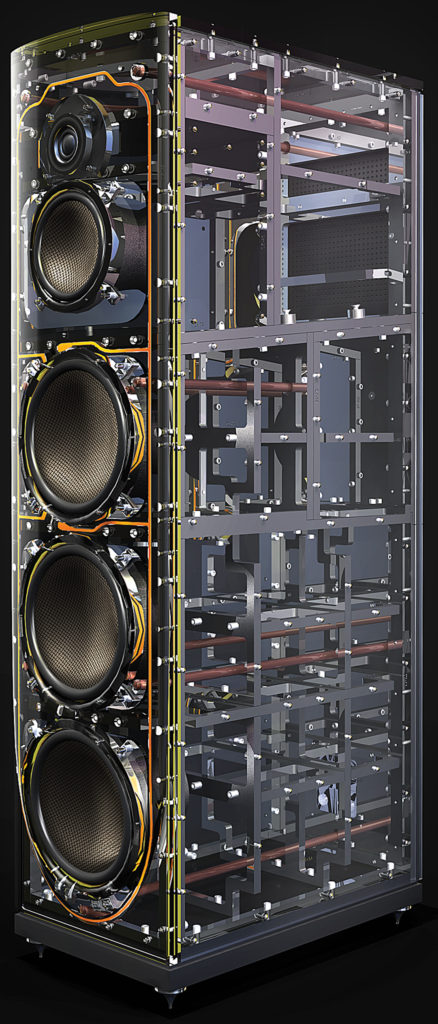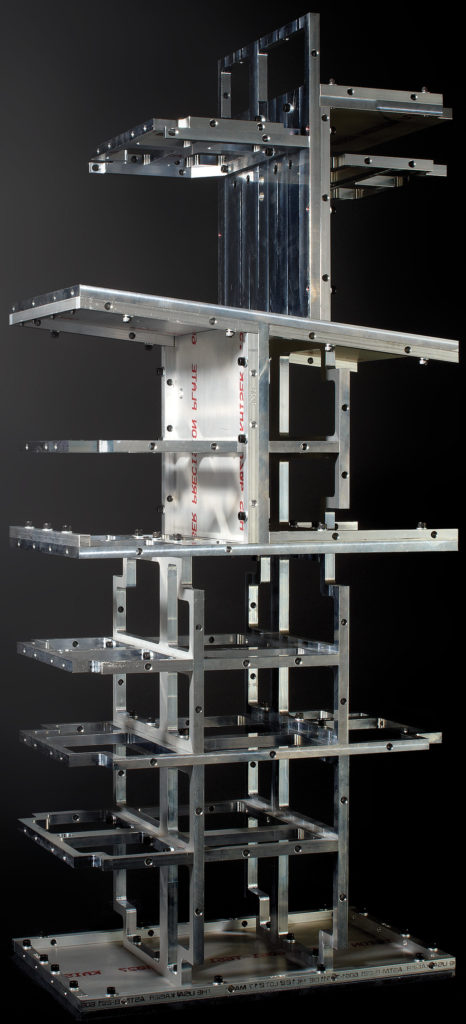Q5 background
The Magico Q5s are heavy, extremely heavy now that I am no longer 25 years old. 420 pounds each, to be exact. When packed in crate, each is at least 500 pounds. Bringing them home was an adventure in itself. (See Part 1) Magico provided a great instruction on how to get the speaker out of the crate and roll them into the room on the industrial casters. But getting the speakers off the casters was a bit tricky. Mine has been sitting on the casters for a year, and I am hesitant to remove the casters in fear of I will ended up on the floor calling out for help with one of the speakers on top of me.
Magico has been a proponent for using aluminum as speaker enclosure for a while. The company acquired its own CNC-equipped machine shop prior to the introduction of the Q5, which brought the cost of constructing the Q5 down. The Q5 uses constrained-layer damped, 6061-T aerospace aluminum enclosures built around elaborate 6061-T aluminum strut frames. I’ve only seen pictures of the inside of the Q5, but I can’t imagine how labor intensive it must be to assemble each speaker. Per Magico’s literature, the frame system alone is assembled from more than 50 machined parts. One sidewall is perforated by nearly 100 threaded holes. There are more than 350 fasteners used with the cabinet even before the front-baffle assembly is attached. Assembling a pair of Q5s takes more than a week.
The four-way, sealed-box design includes Magico’s new MBe-1 beryllium-dome tweeter plus four drivers with Nano-Tec cones. The Beryllium has a high ratio of stiffness to mass, and breakup modes far beyond the audioband. The Nano-cones, designed by Magico and assembled from parts sourced from around the world, consisted of a 6″ midrange, a 9″ midbass, and two 9″ woofers. None has a dustcap, and all feature sandwiches of Rohacell foam coated with carbon nanotubes to produce unusually stiff yet lightweight cones claimed to behave pistonically within their operating bandwidths.
The new midbass driver has a 5″ voice-coil with a copper cap to give super-low inductance. The other drivers are derived from those used in the Magico M5. Magico uses its Bass Mechanical Resonance Cancellation (BMRC) system to offset the drivers’ acoustical centers and angles, though this is not visible from the front baffle. This is claimed to allow the Q5’s low-frequency breakup modes to be acoustically cancelled.
The German electronics specialist Mundorf supplies crossover-network parts built to Magico’s specs. According to Magico specs: The speakers have a sensitivity of 86dB, a nominal impedance of 4 ohms, and a frequency response of 18Hz–50kHz, ±2dB. I would classify these speakers in the not-so-easy loads to drive category. For best results, you will need to employ high-current and high wattage amplifiers. Well, my Pass X350.5 needed some exercise anyways. It had barely lifted a finger all those years driving a pair of Verity Parsifal Encores. And the 20AMP dedicated line from the panel should supply enough juice directly to the power amp should the amp calls for that.
Auditioning
As much as I marveled at the effort Magico put into constructing this speaker, it seems like someone got obsessed with the cabinet resonance issue and went down the deep end. Well, the result speaks for itself, a great disappearance act of the speakers; a complete lack of coloration from the speaker cabinets. The sound are as clean and finely rendered as I’ve ever heard. The presentation is very different than my Verity Parsifal Encores with a ported bass unit that utilize the cabinet to create its sound signature.
I’ve heard many compliments with the Pass Labs X-series amplifiers, most notably their ability to control and render a very authoritative and accuracy bass. The combination of the two produced an amazing low-frequency performance in my room. You can feel the pounding lower registers. The drums are forceful, not bloated; very clean, and every detail is rendered. But it is not just the Q5’s ability to produce those lower octaves. On drums and double bass, you can feel the liveliness of those instruments, the remnant of the attack on the drum surface, and the plucking of the bass strings. I’ve not noticed any exaggeration in this region.
One of the most compliments I have received about the Q5 was its transparency and speed in the upper octaves resembling a ribbon or electrostat speakers. I think it is no small feat for a cone speakers to be able to achieve this. Some companies had simply tried to marry a ribbon tweeter to cone woofers to try to achieve this. The inherent issue with ribbons is the thinness of the image, or the lack of mass giving the image more of a two-dimensional presentation. Magico’s solution presents the best of both worlds.
When I am in my “serious” listening mode, I tend to be more analytical, processing everything I am hearing through my brain. I tend to listen to minute details, maybe picking out a section in the orchestra. In this regard, I would categorize this is another strength of the Q5 in its ability to produce the different layers of information in a very organized manner. The ability to distinguish various instruments in a complex passage of orchestral work was simply amazing. To me, this is what creates that realism in soundstage. If I were to focus on the brass section or the percussion section, I can hear a very well defined space around the instruments and the air around them. Nothing is muddy and blurred from front to back and side to side.
One of the many complaints I have about some of the speakers, especially the MBL is that when you crank up the volume, you ended up with a 10-ft tall giant singing in front of you. With the Q5, I was pleasantly surprised to see that they were very good at presenting a much more believable scale. As you crank up the volume, I feel that I have close the distance between me and the performance, not necessarily magnifying it.
Many will think that the Q5s are probably too colorless, too cold, no character, too “analytical”, no midrange bloom, lacking of slam, or the “wow” factor. It’s true, they don’t jump out and grab you. If you are casually listening, nothing will jump out immediately to grab you. But if you sit down and pay attention to them, you will find that they are faithfully reproducing the music, not calling attention to themselves. Isn’t that what we are looking for in speakers? For me, that’s what I need to get my mind which is often racing at 200 miles per hour to take a detour and focus on the music.
Associated Equipment:
Analog Sources: Transrotor ZET 3.2 + SME V + Shelter Harmony, Furutech La Source Silver lead wires + Furutech AG-12 Phono cable; Michelle Orbe SE + Graham 2.2 + Benz M2 + Clearaudio lead wires + Morrow Audio PH-4 Phono cable.
Digital Source: Mark Levinson #37 + I2Digita DX-60 digital cable + Sonic Frontier SFD2 Mk II (with a pair of Amperex Orange Label 6DJ8)
Amplification: Esoteric E-03 phonostage, ARC Ref 2 Mk I (with GNSC Ref level mod + Amperex PQ White/Orange label E88CC tubes + Matsushiba 5AR4 + RCA black plate 6L6GC + Amperex E88CC) + Pass Labs X350.5
Interconnects: Synergistic Research Absolute Reference X2 XLR & RCA (1.0M), Designer Referece X2 (20 ft)
Speaker Cables: Synergistic Research Resolution Reference X2 (10 ft)
Power Products: 4 dedicated power lines with PS Audio Power Ports Premier. All digital source into PS PP300 into 1 dedicated line. All analog sources into Isotek Nova GII into 1 dedicated line. Power Amp directly into dedicated line. Powercords include Electraglide Epiphany, Reference Glide Mk II, S.O.T.U.; BMI Whale Elite Mk II; Furutech Alph PS-950-18.
Racks: full compliment of Solidtech ROS Reference + Discs of Silence + Feet of Silence
Room Dimensions: 14-ft front width, 16-ft rear-width, 21-ft length, 9ft-hight front with drop-down ceiling to 7-ft, 14-ft height in rear.
- ← Previous page
- (Page 2 of 2)



Thanks for the interesting and informative review. The transportation of the speakers was quite the ordeal. I hope you one day get the speakers off the casters. I will seek out Magico at my next audio show visit.
Frank, Nice review, but much editing needed…. there are 3 woofers for one thing ! Anyway, there is so much redundancy as we have all read about the Magico way ! But, your personal experience of listening was very compelling…. just too brief. I would have been far more interested in hearing about your listening experience as aposed to the logistics and manufacturing !
Q5 has a mid-bass woofer and 2 bass woofers. The mid-bass and bass are crossed at different points, so it’s not quite correct to call it 3 woofers. I agree with the sentiments about the logistics. I don’t care for reading about how they got into the audition room, I only care for reading about the listening impressions encountered during the audition itself. I am somewhat curious why Q5 has been reviewed in the first place. It’s been around for 7 years (which in Magico time is an eternity) and will soon be a legacy product. M6 is new (May 2017) and a far more relevant speaker to review.
He reviewed them because they are his speakers and this was his experience of obtaining them and enjoying them. If you want a review of the latest speaker then buy a magazine. I was happy to hear the issues and opinions of somebody buying with their own “hard earned” not being loaned the speakers for their endorsement.